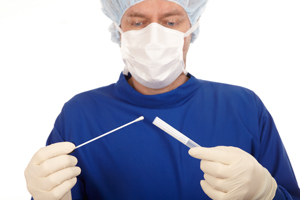PAP Smears: What, Why and When

The purpose of a PAP smear is to look for cancer and other infections before a person develops symptoms.
The National Cancer institute reported 12,200 new cases of cervical cancer and 4,210 cervical cancer deaths in 2010. The majority of these deaths can be prevented by a simple screening called the PAP smear (a collection of cells from the uterus).
Dr. George Papanicolou reported in 1928 that cancer could be detected if vaginal cells were collected and studied under the microscope — hence the name PAP smear. The PAP gained acceptance in the U.S. between 1949 and 1954. Initially, screening was recommended in postpartum women and also yearly in sexually active women. In 2009, with new research and better understanding of the Human papillomavirus (HPV), the American Congress of Obstetrician and Gynecologists (ACOG) established new guidelines.
Purpose Behind the Screen
The purpose of screening is to look for cancer before a person develops symptoms. If a cancer is found in the early stages, it may be easier to treat or eradicate. Prevention is always better than treatment. Cervical cancer is almost always caused by HPV, which is contracted through sexual intercourse. PAP smears will detect abnormal cells including HPV. Obstetricians, gynecologists and primary health care providers perform PAP smears at the time of a pelvic examination.
The ACOG set these PAP smear guidelines:
- First PAP at age 21 regardless of initiation of sexual activity
- Every two years between ages 21 and 29 if screen has been normal three years in a row
- Every three years for ages greater than 30 years if previous screenings have been normal
- At age 65, with a history of normal PAP smears and low-risk population
- After a hysterectomy with no previous history of abnormal PAP smears, then no PAP smears are indicated.

More than 12,000 cases of cervical cancer were diagnosed in the U.S. last year.
PAP smears may be spaced per ACOG guidelines, but if increased or altered vaginal discharge is occurring, then an examination is needed to rule out infections. These could be simple yeast infections or more significant infections like Chlamydia, gonorrhea, trichomonas or herpes. These are easily treatable and most times preventable. If a diagnosis of one of these is established, then both partners must be treated to avoid re-infection and long-term consequences. The symptoms and complications of these infections are more problematic for women: men are usually asymptomatic.
What to Expect
A physical examination usually includes weight, height, blood pressure, a urine test, evaluation of heart and lungs with a stethoscope, palpation of the abdomen and breasts and an overview of the nervous system and skin. A pelvic exam starts with examination of the external genitalia, then a speculum exam inside the vagina and cervix and a PAP smear and cultures for infections. The next step is the bimanual exam that is done to evaluate the size of the uterus and feel for the ovaries and fallopian tubes. This is sometimes the only way to detect any ovarian or uterine tumors. This is why a pelvic examination is still needed every year.
ACOG guidelines are not absolute and a discussion with your health care provider to individualize your screening frequency is important. You may not require a PAP smear yearly, but a physical exam including a pelvic exam is still strongly recommended. High-risk populations, women with HIV, Hepatitis B, C or D, previous history of abnormal PAP smears or multiple sexual partners, will need PAP smears more frequently.
At the time of your physical, it is important to ask if a mammogram, bone scan, cholesterol screening, screening for sexually transmitted infections or a colonoscopy is needed.
Ladies First
Historically, women are known to put themselves last. Their children, partners, parents, siblings and loved ones come first. Take one day out of the 365 days in a year and schedule your physicals, PAP smears and mammograms, so you can provide excellent care to your loved ones for many healthy years to come.
Related Stories
Celebrating Veterans: TTUHSC’s General Martin Clay’s Legacy of Service and Leadership
From his initial enlistment in the Army National Guard 36 years ago to his leadership in military and civilian health care management roles, Major General Martin Clay’s career has been shaped by adaptability, mission focus and service to others.
Texas Tech University Health Sciences Center School of Nursing Named Best Accelerated Bachelor of Science in Nursing Program in Texas
The TTUHSC School of Nursing Accelerated Bachelor of Science in Nursing (BSN) program has been ranked the No. 1 accelerated nursing program in Texas by RegisteredNursing.org.
TTUHSC Names New Regional Dean for the School of Nursing
Louise Rice, DNP, RN, has been named regional dean of the TTUHSC School of Nursing on the Amarillo campus.
Recent Stories
TTUHSC Cancer Researcher Honored by National Academy of Inventors
C. Patrick Reynolds, M.D., Ph.D., director of the School of Medicine Pediatric Cancer Research Center at TTUHSC, has dedicated his life as a researcher to developing treatments for childhood cancers.
TTUHSC School of Nursing Celebrates 10 Years of the Veteran to BSN Program
The TTUHSC School of Nursing recognized the 10-year anniversary of the Veteran to Bachelor of Science in Nursing (VBSN) program during the fall 2025 commencement ceremonies held Dec. 13 in Lubbock, Texas.
TTUHSC Dean to be Inducted into the National Academies of Practice as Distinguished Fellow
Gerard E. Carrino, Ph.D., MPH, dean of the TTUHSC Julia Jones Matthews School of Population and Public Health, will be inducted into the National Academies of Practice (NAP) as a Distinguished Fellow of the Public Health Academy.
